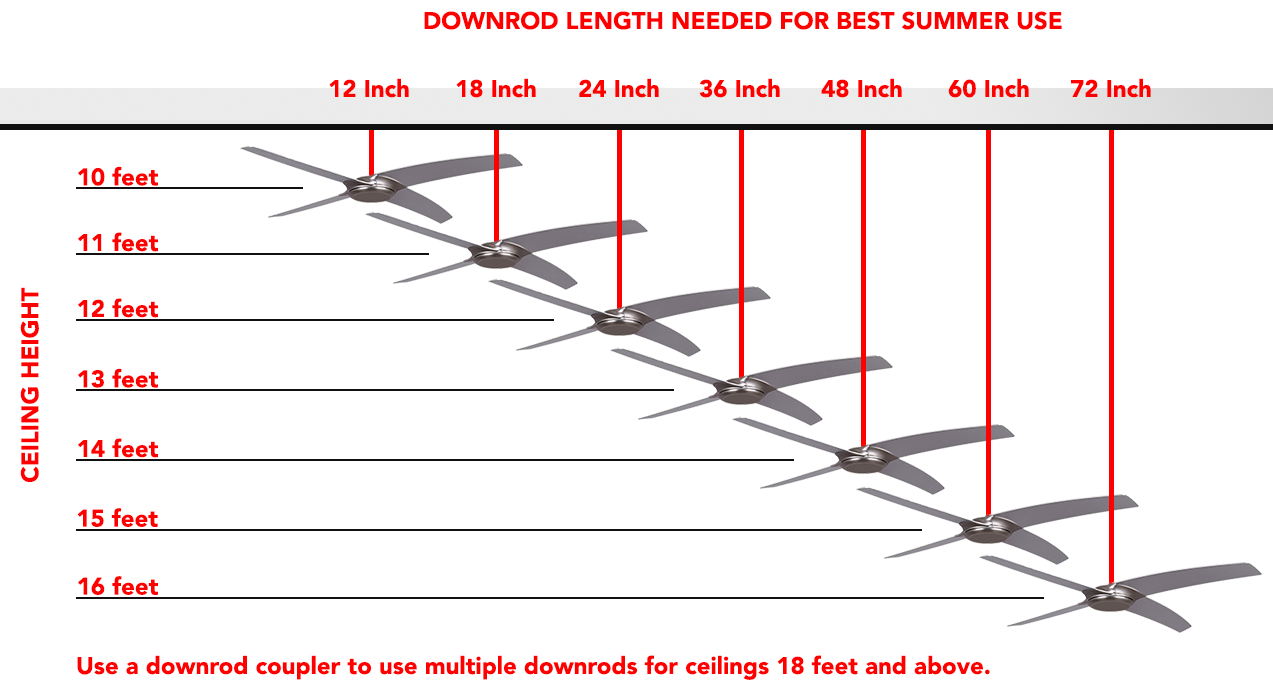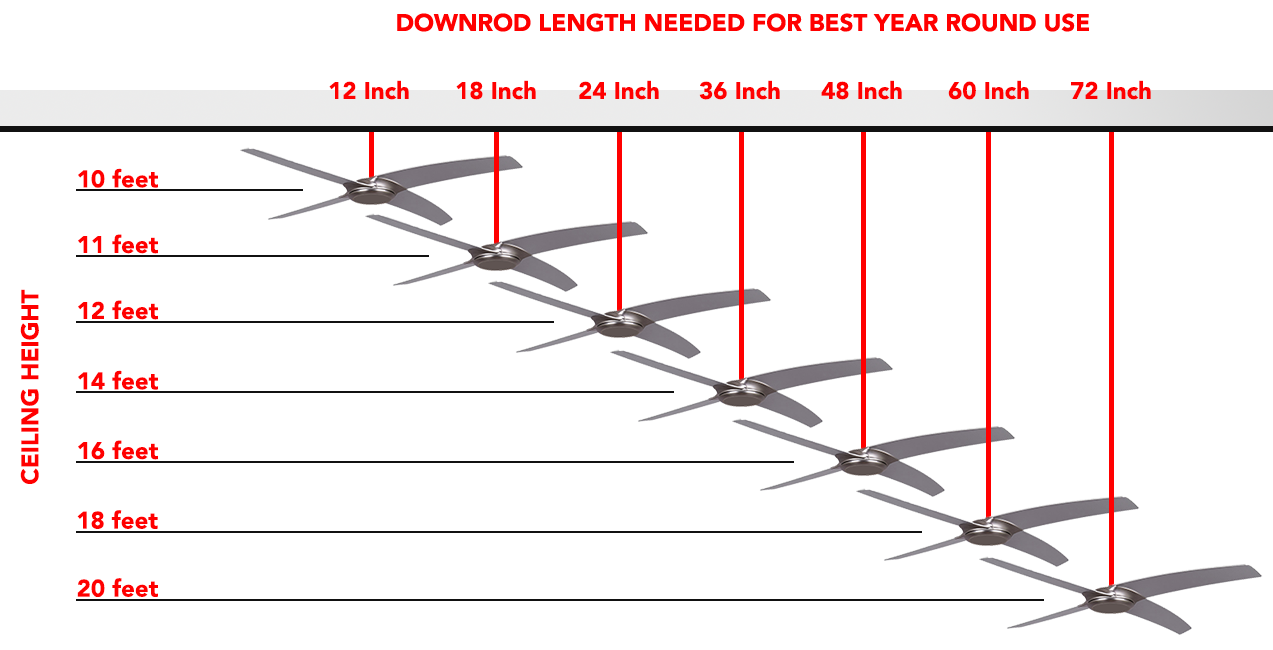Optimal Ceiling Fan Downrod Length for Indoor Use
Print When installing a ceiling fan, you must consider how far the fan needs to drop from the ceiling before beginning the installation process. In some instances the downrod that comes packaged with the fan will be all that's necessary. In others you may need to consider purchasing a longer downrod, or you may even need a close mount kit to bring your new fan closer to the ceiling. But how do you know you’re going to get the hang down distance correct? This article will help you achieve exactly that.
When installing a ceiling fan, you must consider how far the fan needs to drop from the ceiling before beginning the installation process. In some instances the downrod that comes packaged with the fan will be all that's necessary. In others you may need to consider purchasing a longer downrod, or you may even need a close mount kit to bring your new fan closer to the ceiling. But how do you know you’re going to get the hang down distance correct? This article will help you achieve exactly that.
National Building Code Requirement
The national standard distance from the floor to the fan is shown as the minimum distance allowed, not what may be optimal for your situation. This minimum distance is not taken at the bottom of the ceiling fan, but rather taken for the ceiling fan blades. The distance required is a minimum of 7 feet above the floor to the fan blades. The bottom of the fan, or its light (if equipped) can be below this distance. There is no code for how far below the 7' mark the ceiling fan can be, but remember, you should not have the blades drop below a 7’ distance from the floor, if you’re wanting the installation to pass building code.
Most ceiling fans will come packaged with a downrod somewhere in-between 3” and 6”. With the majority of these, the fans are designed for use on a standard celling height of 8 feet. For optimal airflow you will typically find the blades will hang 10 inches from the ceiling (larger fans may need more space). This insures the fan passes building code when installed from a standard 8 foot ceiling.
Proper Downrod Length for Higher Than Normal Ceilings
For taller ceilings, many fan manufacturers suggest dropping a ceiling fan all the way down to 8 to 9 feet from floor level. Although this will create an optimal cooling affect, sometimes dropping them down so low may not look very attractive when hanging from a really high ceiling. Dropping a fan too low also takes away from the open feeling of the room and the extra headroom the height of the room was intended to give.
Ceiling fans will also be able to help in keeping a room warm during the winter months, just as much so as they will for cooling during the summer months. In rooms with soaring ceilings, if a fan is dropped all the way down to just 9’ off the floor, you will lose almost all of its effectiveness for reclaiming lost heat that will become trapped against the ceiling. Therefore, before deciding upon downrod length, we suggest first considering whether you are putting a fan in the room for cooling purposes only, are you putting it in the room for energy savings year round, or are you only looking for the ceiling fan to help with lost heat during the winter months? Knowing this will determine how long of a downrod you should go with.
If you only desire to use your fan during the summer…
If you know you'll only be using your ceiling fan for summer use, choosing downrod length is easy. You will want your new ceiling fan to hang between 8’ and 9’ above the floor, regardless of ceiling height. Most fan bodies (including mounting hardware) are 8 to 12 inches. So, whatever your ceiling height is in feet, buy a downrod that will put the top base of the fan at 10 feet. Then, after adding the rest of the fan into the equation, you will almost always find that your fan is hanging very close to the desired 9' level.
Example: If ceiling height is 14 feet, purchasing a 48” downrod (4 foot) will put the top of the motor just below 10 feet once the mounting hardware is attached to the ceiling. After the rest of the fan is assembled, this will put the bottom of the ceiling fan right at 9 feet above the floor.
See chart below for best downrod length needed for optimal summer only usage.
If you only intend to use your ceiling fan for heating during the winter…
If you’re installing a ceiling fan for the sole purpose of helping to keep heat down at the living level, and from becoming trapped against your high ceiling where it will do you no good, then you will not want to drop the fan away from the ceiling much at all. Only drop it enough for the blades to clear the ceiling by max of a couple of feet.
If you have a flat ceiling this will be easy to calculate, but if you have a peaked cathedral ceiling you will need to measure down from where your new ceiling fan will be installed. Then taking half of the fan’s diameter, measure out to the ceiling to make sure the blades will be clearing the sloped part of your ceiling by 18 inches or so. In doing this, as you measure towards to the ceiling, be sure to keep your measuring tape parallel to the floor.
The reason you want to keep your fan as close to the ceiling as possible, if the ceiling fan’s purpose is for helping with heating during the winter, is because if you drop your fan too low it will be too far below all of that trapped heat that becomes stuck against the ceiling. It will become much less efficient at bringing heat back down to the living level if is installed too far away from the ceiling.
If you’re like most people, you’ll want to extend your fan to the optimal level for even year round usage…
For those of you that understand the benefits of using your ceiling fans year round, you will want to half the distance between the two suggestions above. This will allow your ceiling fan to be just as beneficial during the winter months as it will be during the summer months. This will keep the fan up high enough so that it is still a useful appliance during the colder months, yet low enough to be very efficient during the warmer months. Not only this, but following this method will make the look of your new ceiling fan much more atheistically appealing in relation to the room.
To get perfect year round use follow these simple three steps:
- Measure your total ceiling height.
- Subtract that from 8 feet, which is the lowest point a fan should typically hang down to from a high ceiling.
- Whatever number that is, purchase a downrod that is as close to half of that number in length as possible.
Doing this will put the fan low enough to perform very well during the months you will need it to supplement your cooling system, yet this will leave it high enough to be effective when you need it to supplement your heating system. Plus, installing a fan at these heights just simply looks better.
In Summary
Most ceiling fans are designed to hang from standard ceiling heights of 8’ to 9.5’ tall, without the need to add a longer downrod. If your ceiling is higher than this you will need to use a longer downrod than what the ceiling fan will probably be packaged with. How long should of a downrod you purchase should be determined by how you intend to use your new fan, not simply by looking at a generic chart designed to give optimal airflow for summer only usage.
For more information, or help in deciding which distance will be best for your needs, give our customer service team a call. All you’ll need to do is tell us your ceiling height, and how you plan to use your new ceiling fan, and we will be more than happy to do all of the calculating for you.
Best Ceiling Fan Name Brands
Choose A Category to View Different Ceiling Fan Design Choices
| MODERN OUTDOOR TRADITIONAL SMALL |
LARGE NAUTICAL ORNATE KIDS |
DUAL TROPICAL FLUSH MOUNT CLEARANCE |
FANS WITH LIGHTS RUSTIC MISSION |








